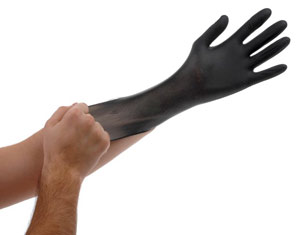By Pamela Dillon, Atlantic Safety Products
Hand protection is a must in the automotive industry. With all the various chemicals, paints, oils and solvents used on the job, choosing the proper hand protection can be difficult. Remember, there is not a “one-glove-fits-all” with disposable hand protection. It’s all based on your specific working conditions and the chemicals and hazards you use on a daily basis.
 “Different glove materials hold up to specific chemicals differently. For example, nitrile holds up well to gasoline, diesel fuel, and turpentine. On the other hand, latex holds up to acetone, ketones and thinners,” explained Linda Kennedy, manager of logistics for Atlantic Safety Products.
“Different glove materials hold up to specific chemicals differently. For example, nitrile holds up well to gasoline, diesel fuel, and turpentine. On the other hand, latex holds up to acetone, ketones and thinners,” explained Linda Kennedy, manager of logistics for Atlantic Safety Products.
Here is some basic information on what you need to look for to help you choose the best hand protection for your class shop.
Glove Materials
• Nitrile: Nitrile was originally formulated as a replacement for natural rubber latex gloves due to latex allergy concerns. It is a synthetic material made to mimic latex, but has no natural rubber latex in it. The properties of the nitrile material allow it to be made thinner, providing better feel without giving up any protective properties. In fact, nitrile gloves are, in general, stronger, more puncture resistant and more chemically resistant than their original latex counterparts.
Nitrile gloves are the most effective replacement for natural rubber, vinyl and neoprene, and are quickly becoming a staple in the industry. Nitrile offers excellent protection against acids, bases, oils, gasoline, solvents, esters and grease. Nitrile gloves are more resistant to snags, punctures, abrasion and cuts than neoprene, latex or PVC gloves. Nitrile also does not contain latex proteins, which may cause allergic reactions.
Because nitrile gloves are so versatile, they are ideal for use in automotive parts handling and assembly, solvent cleaning, chemical processing, painting, battery service and degreasing.
• Latex: Latex is the most universally recognized glove material. Latex gloves hold up to acetones, ketones and thinners.
The main concern associated with latex gloves is latex allergies. Latex allergy is a cumulative allergy, meaning that it can develop over a long period of exposure to the product.
Reduced latex protein gloves were developed for those individuals with latex sensitivities. They have been additionally processed to reduce levels of natural rubber latex (NRL) proteins. While there is insufficient clinical data to calculate the precise amount of extractable latex protein in a latex glove that will cause sensitization or a reaction, it is known that reduced levels of latex protein decrease the risk of sensitization. To support the identification of these gloves, the FDA permits label claims of reduced latex protein (gloves with 50 micrograms or less of total water extractable latex protein per gram).
To help reduce your shop’s risk of latex sensitivity, choose a glove with the “Reduced Latex Protein” claim.
Chemical resistance charts like the downloadable one at www.atlanticsafetyproducts.com are a great resource to aid you in selecting a glove material for your needs.
Powdered vs. Powder Free
Here’s a glove manufacturing secret…most gloves are made with powder, even if they are powder free out of the box! The powder helps release the gloves from the hand molds. Powder-free gloves have been rinsed and dried after coming off the molds to remove any extra powder residue.
Powdered gloves are less expensive to make than their powder-free versions, because they are not washed and dried after manufacturing. They may contain higher levels of the manufacturing chemicals used to produce them, which is then released into the air through the powder in the glove. Powdered latex gloves are almost always not Reduced Latex Protein.
Thickness Counts, Too!
Glove thickness is another consideration in choosing your hand protection. Disposable gloves, no matter what the material, come in various thicknesses to prevent glove degradation with certain chemicals. For example, laquer thinner will require a much thicker latex glove than acetone. Latex gloves can easily be made thicker because the nature of natural rubber latex is that it can stretch easily.
Don’t Forget the Manufacturing Process
The last consideration in choosing your disposable hand protection should be the manufacturing process. Many times the components of a disposable glove, especially the curing agents and accelerators used to harden the liquid glove materials onto the hand molds, can cause hand irritations.
Look for manufacturers who offer “clean” products — gloves that have been additionally washed to remove these irritants, like gloves with the Reduced Latex Protein claim discussed previously. This is also especially important in choosing nitrile gloves. Since nitrile is a synthetic material, the more the gloves are washed after manufacturing, the cleaner and less irritating they will be.
Clean manufacturing will not only help protect you from harmful irritants, but it can also prevent excessive hand perspiration. The cleaner a glove is, the more comfortable it is, and as always, that counts for a lot!
For more information on chemical resistance and glove materials, visit www.atlanticsafetyproducts.com.
